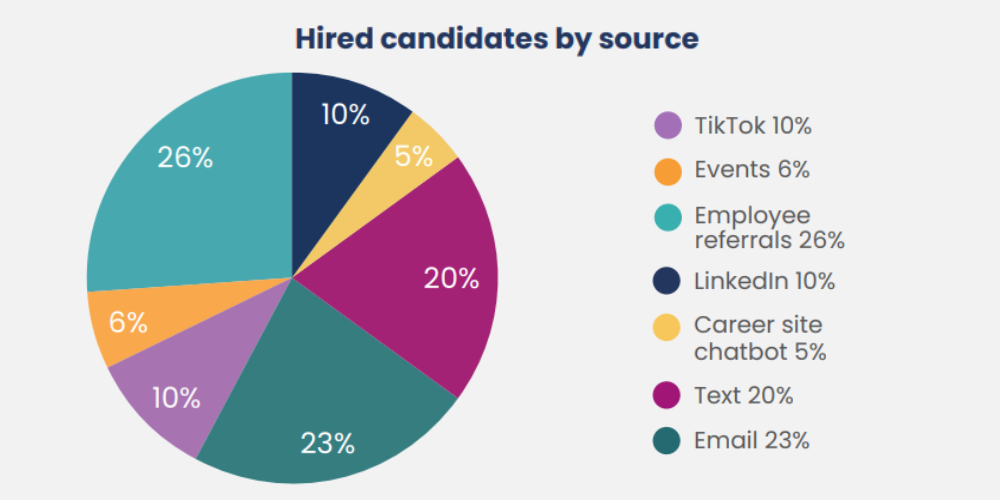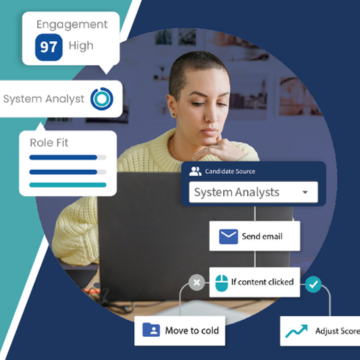- Solutions
- Products
- Community
- Resources
- Company
Create incredible candidate experiences that communicate your brand, mission, and values with recruitment marketing solutions.
Learn moreCommunicate effectively and efficiently with the candidates that can drive your business forward.
Learn moreSelect the right candidates to drive your business forward and simplify how you build winning, diverse teams.
Learn moreHelp your best internal talent connect to better opportunities and see new potential across your entire organization.
Learn moreCommunicate collectively with large groups of candidates and effectively tackle surges in hiring capacity.
Learn moreAccess tools that help your team create a more inclusive culture and propel your DEI program forward.
Learn moreRebound and respond to the new normal of retail with hiring systems that are agile enough to help you forge ahead.
Learn moreAccelerate the hiring of key talent to deliver point of care and support services that meet and exceed your promise of patient satisfaction.
Learn moreAttract and engage candidates with technical competencies, accelerate hiring for much-needed skills, and advance expertise within your valued workforce.
Learn moreSimplify how you recruit finance, insurance, and banking candidates with a unified platform built to match top talent with hard-to-fill roles.
Learn moreYour business strategy depends on your people strategy. Keep both in lockstep with the iCIMS Talent Cloud.
Learn moreBuild an engaging, high-converting talent pipeline that moves your business forward.
Learn moreDeliver the innovation your talent team needs, along with the global scale and security you demand.
Learn moreDeliver tailored technology experiences that delight users and power your talent transformation with the iCIMS Talent Cloud.
Learn moreThe #1 ATS in market share, our cloud-based recruiting software is built for both commercial and large, global employers.
Learn more Talk to salesAttract the best talent for your business with powerful, on-brand career websites that excite candidates and drive engagement.
Learn more Talk to salesCombine behavior-based marketing automation with AI insights to build talent pipelines, engage candidates with multi-channel marketing campaigns, and automatically surface the right talent for the job.
Learn more Talk to salesEmpower candidates with automated self-service, qualification screening, and interview scheduling through an AI-enabled digital assistant.
Learn more Talk to salesSimplify employee onboarding with automated processes that maximize engagement and accelerate productivity.
Learn more Talk to salesCompliment your sourcing and engagement efforts with award-winning lead scoring and advanced campaign personalization.
Learn more Talk to salesImprove employee experience, retention, and reduce internal talent mobility friction with the iCIMS Opportunity Marketplace.
Learn more Talk to salesVerify skills with game-changing levels of automation and simplicity to improve the quality of hire at scale.
Learn more Talk to salesModernize, streamline, and accelerate your communication with candidates and employees.
Learn more Talk to salesTransform the talent experience by showcasing your authentic employer brand through employee-generated video testimonials.
Learn more Talk to salesSimplify recruiting, dynamically engage talent, and reduce hiring bias with job matching and recruiting chatbot technology.
Learn more Talk to salesGet exclusive intel on industry and market trends along with expert one-on-one advice.
Learn more Talk to salesThe #1 ATS in market share, our cloud-based recruiting software is built for both commercial and large, global employers.
Learn more Talk to salesAttract the best talent for your business with powerful, on-brand career websites that excite candidates and drive engagement.
Learn more Talk to salesCombine behavior-based marketing automation with AI insights to build talent pipelines, engage candidates with multi-channel marketing campaigns, and automatically surface the right talent for the job.
Learn more Talk to salesEmpower candidates with automated self-service, qualification screening, and interview scheduling through an AI-enabled digital assistant.
Learn more Talk to salesSimplify employee onboarding with automated processes that maximize engagement and accelerate productivity.
Learn more Talk to salesCompliment your sourcing and engagement efforts with award-winning lead scoring and advanced campaign personalization.
Learn more Talk to salesImprove employee experience, retention, and reduce internal talent mobility friction with the iCIMS Opportunity Marketplace.
Learn more Talk to salesVerify skills with game-changing levels of automation and simplicity to improve the quality of hire at scale.
Learn more Talk to salesModernize, streamline, and accelerate your communication with candidates and employees.
Learn more Talk to salesTransform the talent experience by showcasing your authentic employer brand through employee-generated video testimonials.
Learn more Talk to salesSimplify recruiting, dynamically engage talent, and reduce hiring bias with job matching and recruiting chatbot technology.
Learn more Talk to salesGet exclusive intel on industry and market trends along with expert one-on-one advice.
Learn more Talk to salesHow a beloved restaurant hires 40,000+ annually with a great candidate experience.
Learn moreThousands strong, our global community of talent professionals includes creatives, innovators, visionaries, and experts.
Learn moreTogether we’re creating the world’s largest ecosystem of integrated recruiting technologies.
Learn morePartner with our global professional services team to develop a winning strategy, build your team and manage change.
Learn moreExplore our network of more than 300 certified, trusted third-party service and advisory partners.
Learn moreUncover unique market insights, explore best practices and gain access to talent experts across out library of content.
Get resourcesExpert guidance about recruitment solutions, changes in the industry, and the future of talent.
Learn moreStay up to date with the latest terminology and verbiage in the HR software ecosystem.
Learn moreEmployers everywhere improve hiring efficiently and save money using iCIMS. Estimate the potential business value you can achieve.
Learn moreDive into the Class of 2023 Report highlighting this cohort’s expectations and where employers are willing — and able — to meet them.
Watch nowPartner with iCIMS to build the right strategies, processes, and experience to build a winning workforce.
Learn moreExpert guidance about recruitment solutions, changes in the industry, and the future of talent.
Learn moreThe iCIMS Talent Cloud delivers a secure, agile, and compliant platform designed to empower talent teams, job seekers, and partners with advanced data protection and privacy.
Learn moreView press releases, media coverage, and the latest hiring data. See what analysts are saying about iCIMS.
Learn moreiCIMS is the Talent Cloud company that empowers organizations to attract, engage, hire, and advance the talent that builds a winning workforce.
Learn moreGet to know the award-winning leadership team shaping the future of the recruiting software industry.
Learn moreWe believe the future of work isn't something that "happens" to you. It's something you create. We actively create the future of work with our customers every day.
Learn moreiCIMS is committed to being a responsible and ethical corporate citizen, which is why Environmental, Social and Governance (ESG) initiatives are strategic imperatives.
Learn moreStreamline your tech stack and take advantage of a better user experience and stronger data governance with ADP and the iCIMS Talent Cloud.
Learn moreThe combined power of iCIMS and Infor helps organizations strategically align their business and talent objectives.
Learn moreOur award-winning partnership with Microsoft is grounded in a shared desire to transform the workplace and the hiring team experience.
Learn moreOur partnership with Ultimate Kronos Group (UKG) supports the entire talent lifecycle by bringing frictionless recruiting solutions to UKG Pro Onboarding.
Learn moreLet’s get in touch. Reach out to learn more about iCIMS products and services.
Learn more

At this time last year, 40% of CFOs surveyed by Gartner said they’d turn to cost cutting if inflation persisted for six more months. Well, here we are. Economic conditions aren’t looking up, and organizations continue to take serious measures to reduce costs.
Leaders across all aspects of business are stuck, trying to balance improved outcomes with budget cuts. To get their budget approved, talent leaders need to prove how the investments they’ve planned for 2024 benefit the bottom line.
With a data-driven approach, you can strengthen your relationship with your CFO and make a stronger case for investment in talent acquisition tech.
Next year’s budget should reflect investments in the areas of talent acquisition that will improve the overall bottom line. For many leaders, candidate experience is a top priority because of its impact on hiring goals and consumer behavior. Qualified job seekers are in short supply, so an improved experience can keep gold medalists in your hiring funnel and get them to the offer faster. More skilled talent + shorter time to hire = better business growth.
Once you define your objectives, you’ll need a strategy. What aspects of your candidate experience are working well? Are there any bottlenecks or points of friction? Is your team attracting the right kind of talent at the most efficient cost?
Your recruiting platform should provide analytics that help you answer these questions.
It’s easy to get caught in analysis paralysis — especially if your recruiting platform’s analytics function is just a page full of numbers without meaning or, worse, data dumped into a spreadsheet!
To help you evaluate areas of improvement, use these recruiting metrics to dig into your candidate experience and gain valuable insight into what’s working and what’s not.
Track this metric to determine whether roadblocks on your career site deter candidates from getting their foot in the door. If you get a lot of visits but few conversions, you could add a mobile-friendly browsing experience, AI-powered job recommendations, and chatbots that allow candidates to ask questions.
The actual job application is another common point of friction in the candidate experience. Job seekers want consumer-like experiences. If it takes too long to complete your application, candidates will find an easier option. For more insight, break down this KPI by device type or location.
Using analytics dashboards in your ATS, calculate which recruitment marketing channels bring in the most candidates to focus your efforts and budget on the channels with the most significant impact.
You can also measure your channels by total volume, break them down by talent pools, or filter them by hired candidates to tell a richer story using your talent data.


CPQA determines the total spend required to attract one quality applicant, so you can focus your strategy on the channels that attract the most quality candidates at the lowest average cost.
To measure this, you’ll need to define what makes a “quality applicant.” Is it all candidates who make it past the phone screen or only those who receive a particular score in your ATS? Once you’ve created that definition, you can use this formula:
This KPI helps you identify the channels that bring in the highest number of qualified applicants. For example, a third-party job board may bring in the highest number of candidates overall, but LinkedIn may generate a higher percentage of qualified candidates.
Are you generating enough candidates per open job? Break down this metric by sourcer to identify team members who may need additional training or support to increase their submissions.
How well do your text campaigns work to engage talent? Use this metric to evaluate your performance against a benchmark. If you receive a lot of initial texts but few applications, you may need to edit the language or flow of your text conversations.
Chatbots act as 24/7 virtual recruiters. But it’s time to act if your chatbot isn’t turning conversations into quality applicants (and generating an ROI). Consider adding employee testimonial videos to your chatbot to showcase your culture and the skills required for relevant jobs.
For this critical channel, targeted emails to candidates in your talent pool should push job seekers to take action. Always include a link that candidates can click, so you can track engagement rates.
Measure candidate satisfaction with a standardized survey about your recruitment process. Determine your net promotor score with a satisfaction survey with a ranking of 1-10.
Make survey answers searchable and reportable in your applicant tracking system for more actionable data.
Hopefully, your analysis of these metrics will uncover two or three opportunities to make your process more efficient and reduce costs. Next, you’ll need to put together a business case that details exactly how an investment in better recruiting tech can drive growth.
To jumpstart this process, we’ve curated how-tos, best practices and real-life examples of how talent acquisition teams have advocated for — and received — budget for better tech. These resources include:
2024 is right around the corner, but it’s not too late to make your case for change. Get buy-in from your C-suite with a rock-solid business case that combines quantitative data with real results to prove the value of a better talent acquisition tech stack.


Alex is well-versed in content and digital marketing. He blends a passion for sharp, persuasive copy with creating intuitive user experiences on the web. A natural storyteller, Alex highlights customer successes and amplifies their best practices.
Alex earned his bachelor’s degree at Fairleigh Dickinson University before pursuing his master’s at Montclair State University. When not at work, Alex enjoys hiking, studying history and homebrewing beer.




